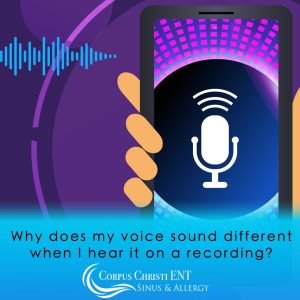 Everyone has had that moment. The moment where they hear their voice recorded on an answering machine or a video and they think to themselves, that’s not what I sound like, is it? It’s the same reason we watch people who try out on singing shows on TV and think, how can they possibly think they sound good? It has to do with physics, yes science!
Everyone has had that moment. The moment where they hear their voice recorded on an answering machine or a video and they think to themselves, that’s not what I sound like, is it? It’s the same reason we watch people who try out on singing shows on TV and think, how can they possibly think they sound good? It has to do with physics, yes science!
In a previous blog, we talked about how the ear works and gave a brief description of how we hear.
When we hear other people talking (or singing) we hear through a method called air conduction. Very simply, sound waves leave the person’s mouth, vibrating the air molecules as they travel through the air to our ear and pass through the auditory system to be processed. The sound waves travel through the ear canal, vibrate the ear drum, cause the little bones in the middle ear to vibrate, and transfer the vibration to the fluid filled inner ear. In the inner ear, the vibration turns into waves which move the small hair cells and trigger nerve impulses to send information about the sound to the brain.
What is different when we hear ourselves talking, is that we hear ourselves through 2 different methods simultaneously. The first method is the same air conduction pathway that we hear others through, and the second is through the second method called bone conduction. In bone conduction, we can vibrate the bones of the skull, which vibrates the fluid located in the inner ear, setting off waves in the fluid that trigger the auditory nerves to send messages to the brain about the sound. In this method we bypass the ear canal and the ear drum and the little bones in the middle ear.
As we speak, our vocal folds create vibrations of air.
Those vibrations can be felt up through the throat. These vibrations can actually be passed on to the bones of our skull. When we vibrate the bones of the skull, we vibrate the fluid in the inner ear, which starts the fluid waves and stimulate hearing that way. The purpose of the outer and the middle ear is to amplify or boost the loudness of some sounds before they reach our fluid-filled sense organ for hearing. There is a practical reason for this to occur, but the main point is, when we hear ourselves through bone conduction, we don’t get that boost in sound. Some pitches of sound will not be heard as loudly as others. That changes the sound quality. Generally, when we hear our voices on a recording, our voices sound higher in pitch than what we hear in our head. It is those higher pitches that are boosted in the ear canal during normal air conduction hearing. Additionally, since we are hearing ourselves through a combination of air conduction and bone conduction, there are two sound signals that are overlapping which also changes the sound quality. It’s like the difference between hearing a single note and a chord. We can not distinguish which part of what we hear is coming through air conduction and which part is through bone conduction, because they blend together. But we can definitely tell when part of it is missing when we hear it again.
And that is why we sound differently to others than we do to ourselves. It’s physics!
If you have any concerns about your hearing, call our office and schedule an appointment for a hearing test.